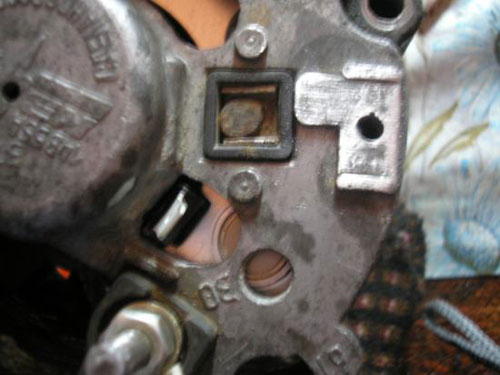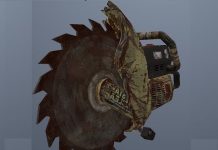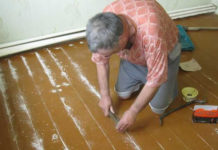In detail: generator g221a do-it-yourself repair from a real master for the site my.housecope.com.
Repair of the G-221 generator
The generator of a VAZ car is disassembled to completely check the health of its elements and replace the faulty stator, rotor, its bearings and rectifier unit.
To disassemble the generator, you will need: keys "for 8", "for 10", "for 13" and "for 19", socket heads "for 8", "for 10" and "for 19", a knob, a torque wrench, a screwdriver , vernier caliper, hammer, mandrels for pressing and pressing generator bearings, generator pulley puller.
1. Unscrew the screw securing the generator brush holder and remove the brush holder.
2. Unscrew the alternator pulley retaining nut by clamping the alternator pulley in a vise through the belts (use a regular alternator belt and some kind of large-section drive belt, for example, from a truck).
3. Using a puller, press the pulley off the generator rotor shaft.
4. Remove the alternator pulley key.
5. Unscrew the four nuts securing the generator cover from the side of the slip rings (rear cover), remove the spring washers.
6. Remove the back cover of the generator together with the stator.
7. Remove the rotor and rear bearing assembly from the generator front cover. Do not lose the spacer ring fitted to the rotor shaft (arrow).
8. Unscrew the nuts securing the front bearing caps by filing the bared ends of the screws.
9. Remove the screws, front bearing inner and outer caps.
10. Press the front rotor shaft bearing out of the generator front cover using a mandrel of the correct diameter.
11. Unscrew the three nuts securing the leads of the stator windings from the rectifier unit, remove the spring washers, remove the bolts with insulating spacers.
| Video (click to play). |
12. Remove the tip of the wire from the terminal block "67" inside the back cover of the generator, pushing it with a screwdriver, and disconnect the back cover and stator.
13. Unscrew the nut securing the output "30", remove the lock and flat washers, as well as the nylon insulating spacer.
14. Remove the rectifier unit from the generator back cover.
15. Using a puller, press the rear bearing off the rotor shaft.
16. Before installation, check the condition of the generator brushes and measure their protrusion from the brush holder (should be at least 12 mm).
17. Assemble the generator in the reverse order of disassembly.
NOTE
After tightening, tighten the nuts of the screws that secure the front bearing caps (see point 8) to prevent them from loosening.
The generator is disassembled for a complete check and validity of its elements and replacement of faulty stator, rotor, its bearings and rectifier unit.
You will need: keys "for 8", "for 10", "for 13" and "for 19", socket heads "for 8", "for 10" and "for 19", a knob, a torque wrench, a screwdriver, a vernier caliper, hammer, mandrels for pressing and pressing generator bearings, generator pulley puller.
1.Loosen the screw securing the generator brush holder and remove the brush holder.
2. Unscrew the alternator pulley fastening nut by clamping the alternator pulley in a vise through the belts (use a standard alternator belt and some kind of large-section drive belt, for example, from a truck).
3.Using a puller, press the pulley off the generator rotor shaft.
4. Remove the alternator pulley key.
5. Unscrew the four nuts securing the cover from the side of the slip rings (back cover), remove the spring washers.
6. Remove the back cover of the generator together with the stator.
7. Remove the rotor and rear bearing assembly from the generator front cover. Do not lose the spacer ring fitted to the rotor shaft (arrow).
8. Unscrew the nuts securing the front bearing caps by filing the bored ends of the screws.
9. Remove the screws, front bearing inner and outer caps.
10. Press the front rotor shaft bearing out of the front cover using an appropriate diameter mandrel.
11.Unscrew the three nuts securing the stator winding leads from the rectifier unit, remove the spring washers, remove the bolts with insulating spacers.
12. Remove the tip of the wire from the terminal block "67" inside the back cover of the generator, pushing it with a screwdriver, and separate the back cover and stator.
13. Unscrew the nut securing the output "30", remove the lock and flat washers, as well as the nylon insulating spacer.
14. Remove the rectifier unit from the generator back cover.
15.Use a puller to press the rear bearing off the rotor shaft.
16. Before installation, check the condition of the generator brushes and measure their protrusion from the brush holder (should be at least 12 mm).
17. Assemble the generator in the reverse order of disassembly.
After tightening, tighten the nuts of the screws that secure the front bearing caps (see step 8) to prevent them from loosening.
This article details the process DIY VAZ 2101 generator repair - disassembly, cleaning, replacement of non-working parts, assembly and installation. The generator will be repaired on the 37.3701 model (it is almost identical to the G222 model).
- Andycar bearings.
- Generator capacitor.
- Diode bridge.
- Nuts 8 (4 pcs).
- Relay regulator (if there is a need to replace it).
I decided not to change my regulator relay, because its condition suits me perfectly.
- A universal puller for removing the bearing, as an option, you can use a rod puller, but I warn you, this is very inconvenient.
- Also find a good metal brush and cloth backed sandpaper.
- Hammer.
- WD-40.
- Standard set of wrenches and screwdrivers.
This is how it looked generator VAZ 2101 before repair, remember it like this, because after the bulkhead it will change beyond recognition 🙂
DIY VAZ 2101 generator repair: disassembly, cleaning, replacement of parts
1. The first step is to clean the generator from dirt, dust, oil, in short, from everything that has accumulated on it over many years of operation.
2. Unscrew the pulley nut, to do this, lay the generator so that its pulley rests on the floor, then put the key on “19” on the nut. Holding the pulley with a wrench from turning, you need to apply several strong and accurate blows with a hammer to the wrench. It is unlikely that it will be possible to clamp the pulley “tightly” by hand, but this will be enough to “rip off” the nut for free unscrewing.
3. Using a “10” wrench, unscrew the four tie rod bolts that assemble the generator into one piece.
4. Take a chisel and knock out the key (see photo above), for this you need to install the generator so that the shaft is on top. Place the chisel on the key and start knocking it out by hitting the chisel with a hammer. 5. After the key is knocked out, remove the generator front cover. In case it goes tight, try knocking out on weight.
Read also:
6. Now remove the relay regulator from the generator.
7. Using the hole under the relay, knock out the rotor, for this you can take a drift. While knocking out, rotate the rotor constantly so that it does not warp.
8. Using the socket at “8”, unscrew the three fastening nuts of the stator, as well as the diode bridge. Here, attention must be paid to the bolts, if they are turned, hold them with the pliers on the back side.
DIY VAZ 2101 generator repair: disassembly, cleaning, replacement of parts
9. It's time to remove the stator, before I did it I sprayed the joints with WD-40 fluid. When everything is a bit sour, we arm ourselves with a hammer again and begin to knock it out. During execution, be extremely careful and careful not to damage anything. When the stator is removed, you need to get the diode bridge.Unscrew the capacitor and press out the rear rotor bearing using the universal puller mentioned at the beginning of the article.
10. Now unscrew the front cover and pull-off plates. The locked bolts that are installed there can be damaged, so at the beginning I did not in vain mention that it is necessary to buy four nuts for “8”. To prevent the bolts from turning when unscrewing, clamp them with pliers on the other side.
11. Remove the plates, then the bearing must be extruded through the mandrel.
As you can see generator VAZ 2101 now it has been completely disassembled, now everything needs to be cleaned, washed, scrubbed, etc. I will not go into details, since I think how to do this is so clear. You will need a metal brush, sandpaper and a knife.
Draw your attention on the fact that since 1996 the place of withdrawal of contact 61 has changed.
My old diode bridge is "old-style", the differences are clearly visible in the photo, on the old one the contact is located on the wire, and on the new one it is soldered into the diode bridge.
Press the bearings into place in the same way, through the mandrel. An important point - when pressing the rear bearing onto the rotor, you need to put the mandrel only on the inner bearing race, while pressing the front one you need to do the opposite - put on the outer one. If you ignore this rule, you can damage the bearing.
You may be interested in:
The rest generator assembly is carried out in the reverse order. Those who had an old-type diode bridge installed will have to tinker with pin 61, it does not fit well into the hole in the back cover. Personally, nothing else came to my mind other than just finishing the hole with a file.
Advice : I recommend sanding the seating plane of the capacitor, this will improve the contact and make it more stable. The rotor is again hammered with a hammer and light blows. At the end of the assembly, do not forget to lock the bolts with a chisel.
This completes the repair of the VAZ 2101 generator, it remains to install it on the car and test it in action. I hope my detailed photo report helped you. Thank you for attention! Those who wish to supplement the article can use the comment form.
Replacing a generator on a car is a common procedure. The generator is not cheap and therefore some drivers have learned to repair it on their own.
In principle, there is nothing complicated in this. Moreover, if you use the step-by-step instructions described below.
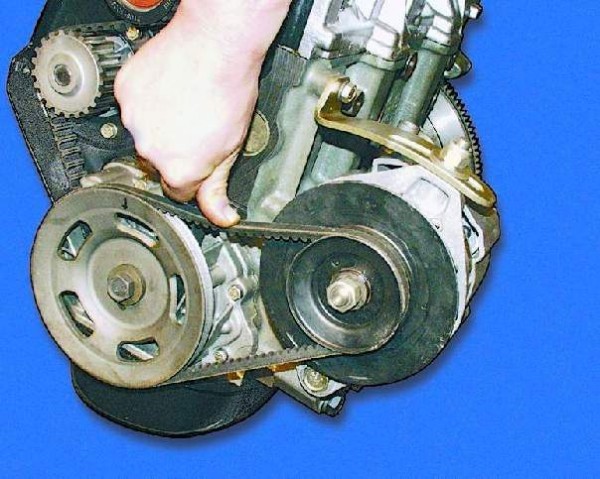
checking the tension of the alternator belt
A car generator is an important mechanism. A lot depends on him, and without his normal work, you won't go far. Malfunctions of the generator on the machine are usually associated with malfunctions of the battery.
Repair of the VAZ 2106 generator is inevitable in these cases. It can be complete or partial, and it all depends on the cause of the failures.
Most often they are associated with a tension belt or bearings.
Start checking the generator with the drive belts, or rather, its sufficient tension.Belt tension is essential for proper generator operation.
We can confidently say that the operation of the water pump and even the bearing of the crankshaft itself depends on a correctly tensioned belt. Loosening the strap will not generate enough electricity for the battery to function properly.
If its tension is too strong, the generator itself often breaks down. It is recommended to change the belt for every 15 t. Kilometers. Well, when cracks, tears or delamination are noticed on it, then even more so.
So, let's start checking.
For this:
- we drown the car (it is advisable that he stood on the pit, since it is more convenient to work with the belt under the machine);
- we raise the car on a jack, if it is not put on a pit;
- remove the protective crankcase;
- we squeeze the belt with our hand up in the center between the pulleys of the generator and the crankshaft (we do not press hard);
- we measure the amount of deflection using a ruler (it should be no more than 10-15 mm).
The discrepancy between the deflection value and the required figures forces the tensioning belt to be adjusted.
Adjusting the VAZ 2106 belt, the repair of the generator of which directly depends on this, implies the following:
- loosening the lower and upper generator mounting nuts;
loosening the lower and upper generator mounting nuts
- diverting the generator from the cylinder block;
- turning the bolt clockwise (two full turns are enough);
drive belt adjustment bolt
- checking the belt tension (if the belt is too tight, then you need to turn the bolt counterclockwise);
- securing the generator in place.
The VAZ 2106 generator, the repair of which is associated with a tension belt, implies a competent approach to business. Indeed, with high tension, increased loads on the bearings of the generator itself and the tension roller are possible, as a result of which they will quickly fail.
With a weak belt tension, it will constantly slip on the pulleys, which will directly affect the operation of the battery.
In cases where the belt cannot be adjusted, it is replaced.
And for this, actions of the following kind are carried out:
- the bolts on the upper and lower mounting of the generator are loosened (the adjusting bolt is also unscrewed by half);
- the generator is moved as close to the cylinders as possible;
- the belt is removed from the generator pulley and crankshaft;
- a new belt is first put on the crankshaft pulley and then on the alternator pulley (in case of difficulty, it is recommended to turn the crankshaft slowly until the belt is put on);
- check belt tension.
Often times, the cause of a generator failure is within the generator. To do this, the generator must be removed and disassembled.
So, we carry out the following actions:
- remove the generator;
- mark a longitudinal mark on it with a felt-tip pen (it will come in handy during assembly);
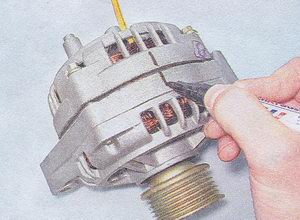
marking a longitudinal line on the generator with a marker
- we manually wring out the latches on the top cover (there are three of them);
- remove the cover;
- unscrew the two screws securing the voltage regulator;
- disconnect the wire from the regulator terminal;
- unscrew the screw securing the capacitor;
- we unscrew the screws fixing the block itself (there should be four of them);
- we take away three wires with terminals in order to remove the rectifier unit;
removing the rectifier unit
- unscrew the contact bolt nut from the rectifier unit;
- remove the washer with a spacer fork;
- we change the capacitor;
- remove the tip of the capacitor wire from the contact bolt;
- we unscrew the four screws holding the flat and spring washers (they are clamped very tightly, therefore it is recommended to use an extension wrench);
- pry off the generator cover from the side of the slip rings with a screwdriver;
- we clamp the generator rotor in a vice and unscrew the nut that secures the pulley;
- remove the pulley itself and the spring washer;
- remove the thrust washer;
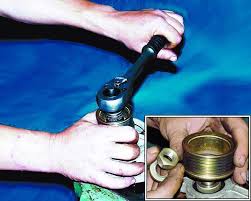
removing the nut securing the pulley
- there is a rotor on the drive side, which must be removed;
- we take out the spacer ring from the rotor shaft;
- we check the slip rings and if they have scuffs, cracks and similar defects, it is required to grind them with fine sandpaper (often this is done on a lathe, followed by processing with sandpaper);
- using an ohmmeter, we check the resistance of the rotor winding by connecting wires to the slip rings (if the tester shows an infinite value, then there is an open circuit and the rotor should be replaced);
- we check with a control lamp the presence of a short circuit in the winding of the rotor body (the photo below shows how to do this);
- proceed to inspect the stator;
- we examine it carefully, trying to find traces of the armature rubbing (if similar symptoms are observed, the bearings are replaced or the general generator cover together with the bearings);
- we check the stator winding with an ohmmeter for an open circuit (for this we connect the test lamp to the output of the stator winding, and the wire from the current source to the body - if the lamp lights up, then the winding or the entire stator needs to be replaced);
- Do-it-yourself repair of the generator also implies an inspection of the generator cover from the drive side (if you feel a backlash during the rotation of the bearing or jamming, or there are traces of grease leakage, or cracks are found in the attachment points, then it is necessary to replace the cover along with the bearings);
- it is also necessary to check the free rotation of the bearing (if there is a play between the rings or jamming, the bearing is replaced);
- we check the generator cover from the side of the slip rings (if serious defects are found, it is replaced with a new one);
- we collect everything in the reverse order, as the instructions indicate (it is necessary to close the cover, on which the line is marked with a marker, and put the pulley spring washer with the convex side to the nut).
This completes the repair of the VAZ 2106 car generator. It is only necessary to highlight a few points. When tightening the last spring washer, a torque of 39-62 Nm can be used.
To make it easier to work with the generator mounting nuts, the battery must be removed. For the convenience of unscrewing the nuts, it is advisable to use a head with a cardan joint and an extension.
When working with the generator, it is recommended to use keys for 10, 17 and 19. It is advisable to remove the generator in the inspection pit or after lifting the car on a jack. That's all there is to it!
The step-by-step instructions given above will help many motorists save good money, because the price of a new generator is quite high today.
A three-phase winding that generates an alternating voltage, after being converted by a built-in bridge rectifier, is capable of delivering direct current up to 42A to the consumption network. Such a current Generator Г 221 able to give already at 1400rpm.
Three-phase bridge rectifier on six diodes of different polarity. In the first models of the generator, the negative diode assembly was located directly in the back cover generator G 221... Subsequently, this unit was redesigned and in subsequent designs, the rectifier unit had the design of a separate unit. Blocks of this design are installed on all modern domestic generators.
End shields, cast from aluminum alloy, are at the same time the generator housing. The generator excitation system is a brush minus brush of the excitation winding connected to the generator body. The excitation voltage is applied to the excitation coil through slip rings and a brush mechanism and is regulated by an electromechanical voltage regulator.
We remove the generator from the engine (see Removing the generator).
Unscrew the nut with the "10" wrench.
... and remove the insulating washer from the output "30" of the generator.
Using the "19" wrench, unscrew the generator pulley nut. Use a screwdriver to hold the rotor against the projection of the impeller (do not bend the blades).
Remove the key from the shaft groove with a small chisel.
... and remove the ring installed behind it.
Using the "10" wrench, unscrew the four nuts.
... and take out the bolts tightening the generator covers.
If the rotor shaft sits tightly in the bearing, holding the generator in weight by the front cover, we knock out the axle through a mandrel made of soft metal.
Remove the adjusting washer. Remember to put it back in place when assembling.
To replace the front bearing with a "8" wrench, unscrew the four nuts. During assembly, they were locked - the ends of the studs were crumpled. If the nuts are damaged when loosening, new ones will be required during assembly.
We remove the outer and inner covers together with the studs.
We knock out the front bearing through the mandrel.
We install a new bearing by applying light blows to its outer ring through a mandrel, which can be used as a suitable head or bushing.
We install the bearing caps, tighten the nuts.
... and we will counter them again with a beard or chisel.
Use a soft metal drift to knock the rotor out of the back cover. The rotor is removed together with the bearing.
Replacing the rear bearing is rarely required. If necessary, pull it off the rotor shaft with a puller.
We press in the new bearing, striking through the mandrel - and only on its inner ring.
Using the "8" head, unscrew the three nuts securing the stator leads to the rectifier unit.
Using a thin screwdriver, tightening the clamp of the "neutral" wire plug.
We remove three bolts from the back cover together with insulating gaskets.
... and take out the rectifier unit.
To check the rectifier unit, see the section Checking the generator.
The valve (diode) has one-way conductivity. A faulty one, as a rule, passes current in both directions. Replacing individual valves is possible, but they will need to be repressed into the holder - an operation that requires accuracy and skill. Therefore, we recommend replacing the rectifier unit in the event of failure of its elements.
By alternately connecting the ohmmeter probes to the stator terminals, we check its windings for an open.
Replace the defective stator
Before assembly, we clean all parts from oil, dirt and coal dust. We wipe the slip rings with a cloth soaked in gasoline or solvent. With strong oxidation and burning, we clean the rings with the finest sandpaper.
We assemble the generator in the reverse order of disassembly. Before installing the stator in the back cover, insert the plug of the "neutral" wire (after bending its latch) into the connecting block of the generator.
This article details the process DIY VAZ 2101 generator repair - disassembly, cleaning, replacement of non-working parts, assembly and installation. The generator will be repaired on the 37.3701 model (it is almost identical to the G222 model).
- Andycar bearings.
- Generator capacitor.
- Diode bridge.
- Nuts 8 (4 pcs).
- Relay regulator (if there is a need to replace it).
I decided not to change my regulator relay, because its condition suits me perfectly.
- A universal puller for removing the bearing, as an option, you can use a rod puller, but I warn you, this is very inconvenient.
- Also find a good metal brush and cloth backed sandpaper.
- Hammer.
- WD-40.
- Standard set of wrenches and screwdrivers.
This is how it looked generator VAZ 2101 before repair, remember it like this, because after the bulkhead it will change beyond recognition 🙂
DIY VAZ 2101 generator repair: disassembly, cleaning, replacement of parts
1. The first step is to clean the generator from dirt, dust, oil, in short, from everything that has accumulated on it over many years of operation.
2.Unscrew the pulley nut, for this, lay the generator so that its pulley rests on the floor, then put the key on “19” on the nut. Holding the pulley with a wrench from turning, you need to apply several strong and accurate blows with a hammer to the wrench. It is unlikely that it will be possible to clamp the pulley “tightly” by hand, but this will be enough to “rip off” the nut for free loosening.
3. Using a “10” wrench, unscrew the four tie rod bolts that assemble the generator into one piece.
4. Take a chisel and knock out the key (see photo above), for this you need to install the generator so that the shaft is on top. Place the chisel on the key and start knocking it out by hitting the chisel with a hammer. 5. After the key is knocked out, remove the generator front cover. In case it goes tight, try knocking out on weight.
Read also:
6. Now remove the relay regulator from the generator.
7. Using the hole under the relay, knock out the rotor, for this you can take a drift. While knocking out, rotate the rotor constantly so that it does not warp.
8. Using the socket at “8”, unscrew the three fastening nuts of the stator, as well as the diode bridge. Here, attention must be paid to the bolts, if they are turned, hold them with pliers on the back side.
DIY VAZ 2101 generator repair: disassembly, cleaning, replacement of parts
9. It's time to remove the stator, before I did it I sprayed the joints with WD-40 fluid. When everything is a bit sour, we arm ourselves with a hammer again and begin to knock it out. During execution, be extremely careful and careful not to damage anything. When the stator is removed, you need to get the diode bridge. Unscrew the capacitor and press out the rear rotor bearing using the universal puller mentioned at the beginning of the article.
10. Now unscrew the front cover and pull-off plates. The locked bolts that are installed there can be damaged, so at the beginning I did not in vain mention that it is necessary to buy four nuts for “8”. To prevent the bolts from turning when unscrewing, clamp them with pliers on the other side.
11. Remove the plates, then the bearing must be extruded through the mandrel.
As you can see generator VAZ 2101 now it has been completely disassembled, now everything needs to be cleaned, washed, scrubbed, etc. I will not go into details, since I think how to do this is so clear. You will need a metal brush, sandpaper and a knife.
Draw your attention on the fact that since 1996 the place of withdrawal of contact 61 has changed.
My old diode bridge is "old-style", the differences are clearly visible in the photo, on the old one the contact is located on the wire, and on the new one it is soldered into the diode bridge.
Press the bearings into place in the same way, through the mandrel. An important point - when pressing the rear bearing onto the rotor, you need to put the mandrel only on the inner bearing race, while pressing the front one you need to do the opposite - put on the outer one. If you ignore this rule, you can damage the bearing.
You may be interested in:
The rest generator assembly is carried out in the reverse order. Those who had an old-type diode bridge installed will have to tinker with pin 61, it does not fit well into the hole in the back cover. Personally, nothing else came to my mind other than just finishing the hole with a file.


Advice : I recommend sanding the seating plane of the capacitor, this will improve the contact and make it more stable. The rotor is again hammered with a hammer and light blows. At the end of the assembly, do not forget to lock the bolts with a chisel.
This completes the repair of the VAZ 2101 generator, it remains to install it on the car and test it in action. I hope my detailed photo report helped you. Thank you for attention! Those who wish to supplement the article can use the comment form.
The generator in cars is designed to generate electricity and charge the battery.If the normal operation of the car electric generator is disrupted, the battery begins to discharge and soon the car will stop starting at all - there will not be enough battery charge. This device consists of a three-phase diode bridge, which in turn has 6 silicon diodes. Electric voltage is created by excitation of the current rectifier at the moment when the rotor poles change under the stator windings. As the rotor rotates inside the machine stator, the rotor poles change. To increase the value of the magnetic fluxes, the stator contains an electromagnetic exciting winding in the area of the magnetic circuits. Wire marking and designation:
- P - pink.
- F - purple.
- O is orange.
- BW - black and white.
- KB - brown-white.
- ChG - black and blue.
- K - brown.
- H - black.
- B - white.
Structurally, the 2101 generator consists of the following main elements:
- Rotor - the movable part, rotates from the engine crankshaft. Has an excitation winding.
- Stator - the stationary part of the generator also has a winding.
- Front and back covers, inside which the bearings are installed. They have lugs for attaching to the internal combustion engine. A capacitor is located in the back cover, which is necessary to cut off the alternating current component.
- Semiconductor bridge - called "horseshoe" for the resemblance. Three pairs of semiconductor power diodes are mounted on a horseshoe-shaped base.
- Pulley, on which the VAZ-2101 generator belt is put on. The belt is wedge-shaped (on modern cars, a multi-groove is used).
- Voltage regulator installed in the engine compartment, away from the generator. But still it must be considered part of the structure.
- Brushes mounted inside the generator and transmit the supply voltage to the excitation winding (on the rotor).
1 - storage battery; 2 - negative diode; 3 - additional diode; 4 - generator; 5 - positive diode; 6 - stator winding; 7 - voltage regulator; 8 - rotor winding; 9 - capacitor for suppressing radio interference; 10 - mounting block; 11 - control lamp of the battery charge in the instrument cluster; 12 - voltmeter; 13 - ignition relay; 14 - ignition switch.
The VAZ-2108 generator has a rather massive stator winding, since it uses a large cross-section wire. It is with its help that electricity is generated. The wire is wound evenly over the entire inner surface of the stator in the recesses specially provided for this purpose in the magnetic circuit. We should also talk about the latter separately. The middle section, the generator stator, consists of a set of thin metal plates pressed tightly together. Often they are boiled on the outside so that delamination does not occur.
- Alternator. Series 37.3701 or 94.3701 can be installed.
- Negative diode.
- Additional diode.
- Positive diode.
- The control lamp of the generator, it is also the discharge lamp of the battery.
- A combination of devices.
- Voltmeter.
- Relay and fuse box located in the engine compartment in the compartment between the engine and the passenger compartment.
- Additional resistors built into the fuse box.
- Ignition relay.
- Egnition lock.
- Accumulator battery.
- Capacitor.
- Rotor winding.
- The voltage relay is located in the engine compartment.
On cars VAZ-2110, 2111 and 2112, a 94.3701 generator was installed with a maximum output current of 80 Amperes and a voltage of 13.2-14.7 Volts.
We give a decryption generator connection diagrams for a dozen:
- 12V battery;
- generator 94.3701;
- mounting block;
- egnition lock;
- battery charge indicator lamp in the instrument cluster
How to check a vaz generator on the example of model 2109. Generator type 94.3701 alternating current, three-phase, with built-in rectifier unit and electronic voltage regulator, right rotation.
Alternator wiring diagram... The voltage to excite the generator when the ignition is turned on is supplied to the “D +” terminal of the regulator (“D” terminal of the generator) through a test lamp 4 located in the instrument cluster. After starting the engine, the excitation winding is powered by three additional diodes installed on the rectifier unit of the generator. The operation of the generator is monitored by a warning lamp in the instrument cluster. When the ignition is turned on, the lamp should be on, and after starting the engine, it should go out, if the generator is working properly. The bright burning of the lamp or its glow in the incandescent floor indicates a malfunction.
The "minus" of the storage battery must always be connected to ground, and the "plus" must be connected to the terminal "B +" of the generator. Failure to re-insert the battery will immediately cause increased current through the alternator valves and damage them.
It is not allowed to operate the generator with a disconnected battery. This will cause short-term overvoltages at the “B +” terminal of the generator, which can damage the generator voltage regulator and electronic devices in the vehicle's on-board network.
It is forbidden to check the generator's performance "for a spark" even by short-term connection of the "B +" clamp of the generator to ground. In this case, a significant current flows through the valves, and they are damaged.
The generator on a VAZ car is removed either for a complete replacement in case of failure or for repair work to replace faulty parts. To carry out dismantling, prepare a standard set of tools, it is advisable to drive the car into the inspection pit.
- Disconnect the battery.
- Remove the protective rubber cap from the terminal "30" and unscrew the nut, remove the wires from the hairpin.
- Disconnect the block with wires from the generator connector.
- We loosen the tightening of fastening the generator to the adjusting plate, after which
we raise it all the way up to the cylinder block and remove the belt from the pulleys. - Completely unscrew the bolt securing the adjusting plate to the cylinder block, then unscrew the 2 bolts attaching the lower bracket to the block from the bottom of the car and remove the generator by pulling it out of the engine compartment.
Profile
Group: Asset
Posts: 9
User #: 18162
On the forum since: 09/12/2010
Has warnings:
(0%)
Profile
Group: Old people
Posts: 2693
User #: 22022
On the forum since: 11/28/2011
Has warnings:
(0%)
Profile
Group: Assistants
Posts: 182
User #: 14815
On the forum since: 08/13/2009
Has warnings:
(0%)
Profile
Group: Old people
Posts: 2693
User #: 22022
On the forum since: 11/28/2011
Has warnings:
(0%)
It is noteworthy that this harmful phenomenon should not be attributed to the prescription and to "type A shitty machines of the past." Some modern rotors are assembled (generally in "g") in fit, on a large (!) Lathe "knurling" and even a side impact when the rotor (removed) falls, for example, one beak in the diagonal can be freely displaced from the table (a little) forever upsetting the balance. For this reason, the planned “weakness” of modern generators, I stopped doing rotor repairs altogether. And on some, it has already become dangerous to change the bearings. Literally the day before yesterday I was dealing with a BMW 525i on which the bearings were replaced before the sale. two days of work at the new Maladogo Active boy (a la slipper on the floor) and the generator is full of a wedge before the fire. So I understand that in the case of such high-speed transmissions to the rotor, it would not hurt to check that rotor for balance already relatively from the newly installed bearings.
| Video (click to play). |
And on winding up the winding up to 4 Ohms on the "classic" this is an ordinary case for me, as well as winding up to 3.3 Ohms when installing the "06-01" x internals in the "07 (9)" generator (with built-in PP). Sometimes they bring everything in a heap. then help out. then they themselves will rearrange .. something else the fathers rearranged but in the corner of the garage was lying. As if already there are almost no "kopecks-six", but developments are still required. Not hitting the voltage when winding up "extra" turns can be attributed to anything.for example, to coincide with a weak mass on an engine that has a weak PP. but you never know. whoever wants to bother with the "oldies" - in the trash and that's all.

